分词独立主格with复合结构doing
- 格式:ppt
- 大小:314.00 KB
- 文档页数:13
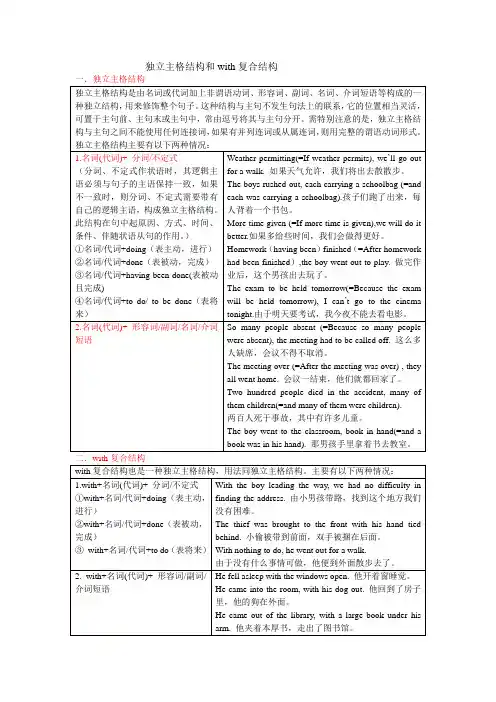
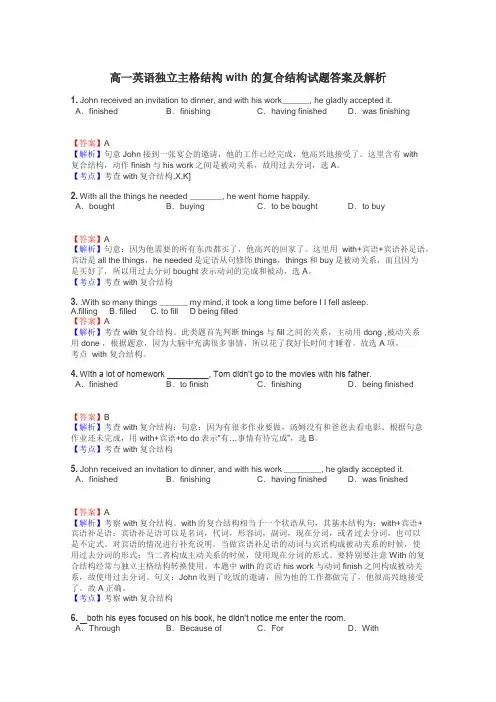
高一英语独立主格结构with的复合结构试题答案及解析1. John received an invitation to dinner, and with his work______, he gladly accepted it. A.finished B.finishing C.having finished D.was finishing【答案】A【解析】句意John接到一张宴会的邀请,他的工作已经完成,他高兴地接受了。
这里含有with复合结构,动作finish与his work之间是被动关系,故用过去分词,选A。
【考点】考查with复合结构,X,K]2. With all the things he needed _______, he went home happily.A.bought B.buying C.to be bought D.to buy【答案】A【解析】句意:因为他需要的所有东西都买了,他高兴的回家了。
这里用with+宾语+宾语补足语,宾语是all the things,he needed是定语从句修饰things,things和buy是被动关系,而且因为是买好了,所以用过去分词bought表示动词的完成和被动,选A。
【考点】考查with复合结构3. .With so many things ______ my mind, it took a long time before I I fell asleep.A.fillingB. filledC. to fill D being filled【答案】A【解析】考查with复合结构。
此类题首先判断things 与fill之间的关系,主动用dong ,被动关系用done ,根据题意,因为大脑中充满很多事情,所以花了我好长时间才睡着。
故选 A项。
考点 with 复合结构。
4.With a lot of homework _________, Tom didn’t go to the movies with his father.A.finished B.to finish C.finishing D.being finished【答案】B【解析】考查with复合结构:句意:因为有很多作业要做,汤姆没有和爸爸去看电影。
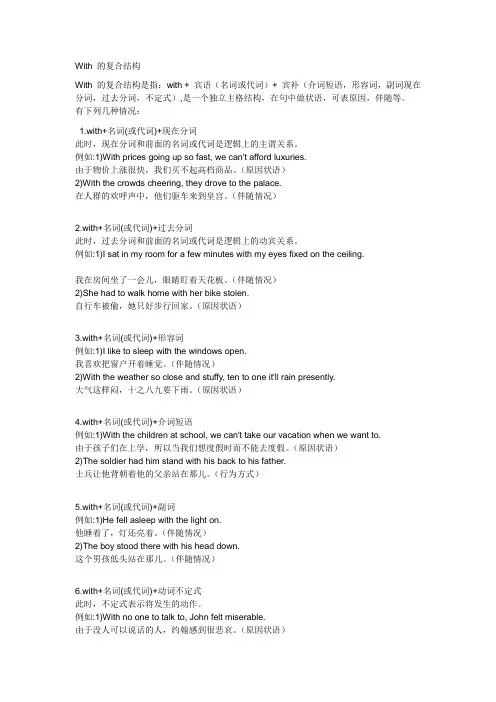
With 的复合结构With 的复合结构是指:with + 宾语(名词或代词)+ 宾补(介词短语,形容词,副词现在分词,过去分词,不定式),是一个独立主格结构,在句中做状语,可表原因,伴随等。
有下列几种情况:1.with+名词(或代词)+现在分词此时,现在分词和前面的名词或代词是逻辑上的主谓关系。
例如:1)With prices going up so fast, we can't afford luxuries.由于物价上涨很快,我们买不起高档商品。
(原因状语)2)With the crowds cheering, they drove to the palace.在人群的欢呼声中,他们驱车来到皇宫。
(伴随情况)2.with+名词(或代词)+过去分词此时,过去分词和前面的名词或代词是逻辑上的动宾关系。
例如:1)I sat in my room for a few minutes with my eyes fixed on the ceiling.我在房间坐了一会儿,眼睛盯着天花板。
(伴随情况)2)She had to walk home with her bike stolen.自行车被偷,她只好步行回家。
(原因状语)3.with+名词(或代词)+形容词例如:1)I like to sleep with the windows open.我喜欢把窗户开着睡觉。
(伴随情况)2)With the weather so close and stuffy, ten to one it'll rain presently.大气这样闷,十之八九要下雨。
(原因状语)4.with+名词(或代词)+介词短语例如:1)With the children at school, we can't take our vacation when we want to.由于孩子们在上学,所以当我们想度假时而不能去度假。
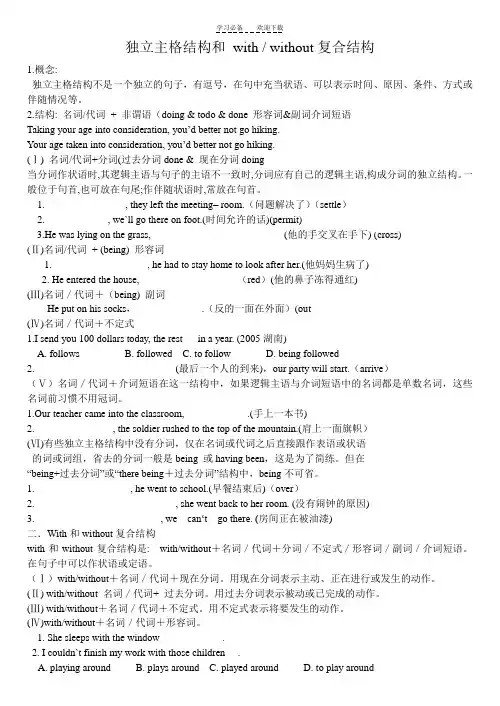
独立主格结构和with / without复合结构1.概念:独立主格结构不是一个独立的句子,有逗号,在句中充当状语、可以表示时间、原因、条件、方式或伴随情况等。
2.结构: 名词/代词+ 非谓语(doing & todo & done 形容词&副词介词短语Taking your age into consideration, y ou’d better not go hiking.Your age taken into consideration, you’d better not go hik ing.(Ⅰ) 名词/代词+分词(过去分词done & 现在分词doing当分词作状语时,其逻辑主语与句子的主语不一致时,分词应有自己的逻辑主语,构成分词的独立结构。
一般位于句首,也可放在句尾;作伴随状语时,常放在句首。
1.________________, they left the meeting– room.(问题解决了)(settle)2.____________ , we`ll go there on foot.(时间允许的话)(permit)3.He was lying on the grass, __________________________(他的手交叉在手下) (cross)(Ⅱ)名词/代词+ (being) 形容词1._________________, he had to stay home to look after her.(他妈妈生病了)2. He entered the house, ___________________(red)(他的鼻子冻得通红)(Ⅲ)名词/代词+(being) 副词He put on his socks,_____________.(反的一面在外面)(out(Ⅳ)名词/代词+不定式1.I send you 100 dollars today, the rest __ in a year. (2005湖南)A. followsB. followedC. to followD. being followed2.__________________________ (最后一个人的到来),our party will start.(arrive)(Ⅴ)名词/代词+介词短语在这一结构中,如果逻辑主语与介词短语中的名词都是单数名词,这些名词前习惯不用冠词。
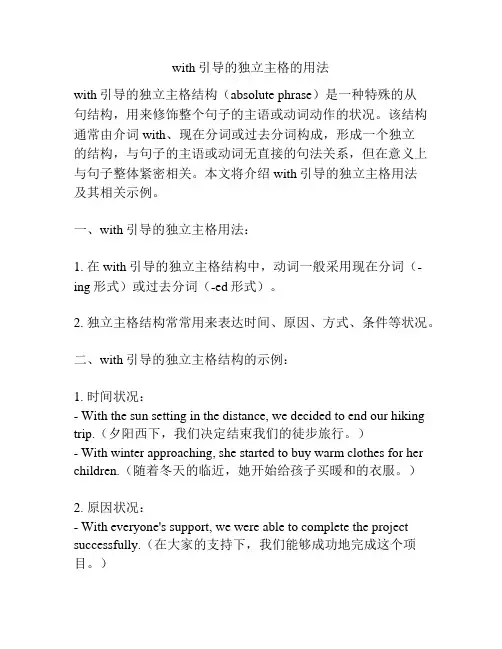
with引导的独立主格的用法with引导的独立主格结构(absolute phrase)是一种特殊的从句结构,用来修饰整个句子的主语或动词动作的状况。
该结构通常由介词with、现在分词或过去分词构成,形成一个独立的结构,与句子的主语或动词无直接的句法关系,但在意义上与句子整体紧密相关。
本文将介绍with引导的独立主格用法及其相关示例。
一、with引导的独立主格用法:1. 在with引导的独立主格结构中,动词一般采用现在分词(-ing形式)或过去分词(-ed形式)。
2. 独立主格结构常常用来表达时间、原因、方式、条件等状况。
二、with引导的独立主格结构的示例:1. 时间状况:- With the sun setting in the distance, we decided to end our hiking trip.(夕阳西下,我们决定结束我们的徒步旅行。
)- With winter approaching, she started to buy warm clothes for her children.(随着冬天的临近,她开始给孩子买暖和的衣服。
)2. 原因状况:- With everyone's support, we were able to complete the project successfully.(在大家的支持下,我们能够成功地完成这个项目。
)- With her brother's encouragement, she decided to pursue her dream of becoming a doctor.(在她兄弟的鼓励下,她决定追求成为一名医生的梦想。
)3. 方式状况:- With great care, the teacher explained the difficult concept to the students.(老师非常用心地向学生解释了这个难懂的概念。

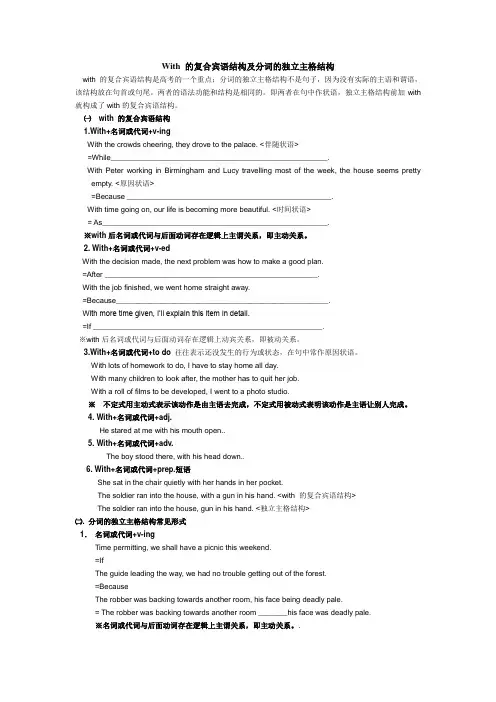
With 的复合宾语结构及分词的独立主格结构with 的复合宾语结构是高考的一个重点;分词的独立主格结构不是句子,因为没有实际的主语和谓语,该结构放在句首或句尾。
两者的语法功能和结构是相同的。
即两者在句中作状语,独立主格结构前加with 就构成了with的复合宾语结构。
㈠with 的复合宾语结构1.With+名词或代词+v-ingWith the crowds cheering, they drove to the palace. <伴随状语>=While____________________________________________________.With Peter working in Birmingham and Lucy travelling most of the week, the house seems pretty empty. <原因状语>=Because _________________________________________________.With time going on, our life is becoming more beautiful. <时间状语>= As______________________________________________________.※with后名词或代词与后面动词存在逻辑上主谓关系,即主动关系。
2. With+名词或代词+v-edWith the decision made, the next problem was how to make a good plan.=After ___________________________________________________.With the job finished, we went home straight away.=Because___________________________________________________.With more time given, I’ll explain this item in detail.=If _______________________________________________________.※with后名词或代词与后面动词存在逻辑上动宾关系,即被动关系。
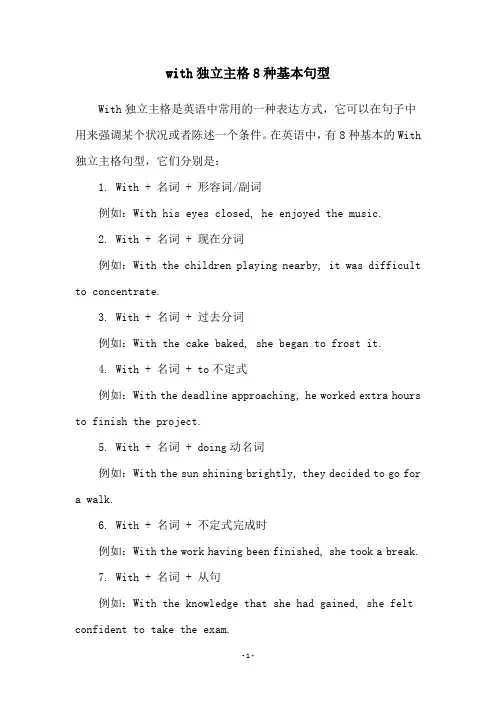
with独立主格8种基本句型With独立主格是英语中常用的一种表达方式,它可以在句子中用来强调某个状况或者陈述一个条件。
在英语中,有8种基本的With 独立主格句型,它们分别是:1. With + 名词 + 形容词/副词例如:With his eyes closed, he enjoyed the music.2. With + 名词 + 现在分词例如:With the children playing nearby, it was difficult to concentrate.3. With + 名词 + 过去分词例如:With the cake baked, she began to frost it.4. With + 名词 + to不定式例如:With the deadline approaching, he worked extra hours to finish the project.5. With + 名词 + doing动名词例如:With the sun shining brightly, they decided to go fora walk.6. With + 名词 + 不定式完成时例如:With the work having been finished, she took a break.7. With + 名词 + 从句例如:With the knowledge that she had gained, she felt confident to take the exam.8. With + 名词 + 介词短语例如:With his hand on her shoulder, he reassured her that everything would be alright.这8种With独立主格句型在英语中使用非常广泛,可以用来表达各种不同的情境和意思。
学会运用它们,能够让我们的英语表达更加地流畅自然。

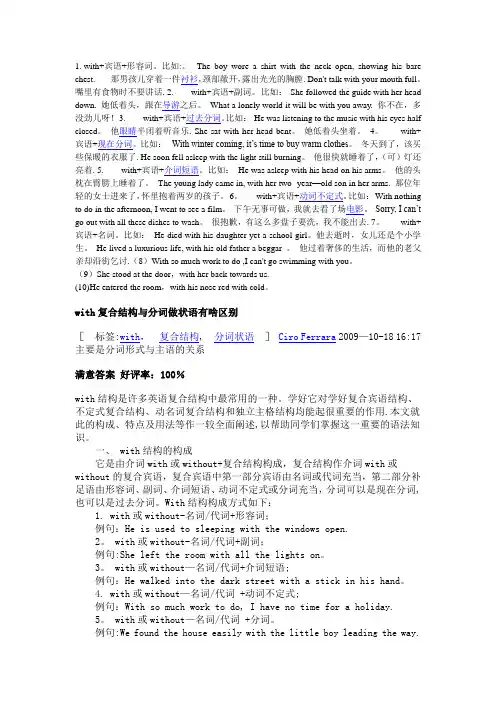
1. with+宾语+形容词。
比如:。
The boy wore a shirt with the neck open, showing his bare chest. 那男孩儿穿着一件衬衫,颈部敞开,露出光光的胸膛. Don't talk with your mouth full。
嘴里有食物时不要讲话.2. with+宾语+副词。
比如: She followed the guide with her head down. 她低着头,跟在导游之后。
What a lonely world it will be with you away. 你不在,多没劲儿呀!3. with+宾语+过去分词。
比如: He was listening to the music with his eyes half closed。
他眼睛半闭着听音乐. She sat with her head bent。
她低着头坐着。
4。
with+宾语+现在分词。
比如:With winter coming, it’s time to buy warm clothes。
冬天到了,该买些保暖的衣服了. He soon fell asleep with the light still burning。
他很快就睡着了,(可)灯还亮着. 5. with+宾语+介词短语。
比如:He was asleep with his head on his arms。
他的头枕在臂膀上睡着了。
The young lady came in, with her two- year—old son in her arms. 那位年轻的女士进来了,怀里抱着两岁的孩子。
6。
with+宾语+动词不定式。
比如:With nothing to do in the afternoon, I went to see a film。
下午无事可做,我就去看了场电影。
Sorry, I can’t go out with all these dishes to wash。
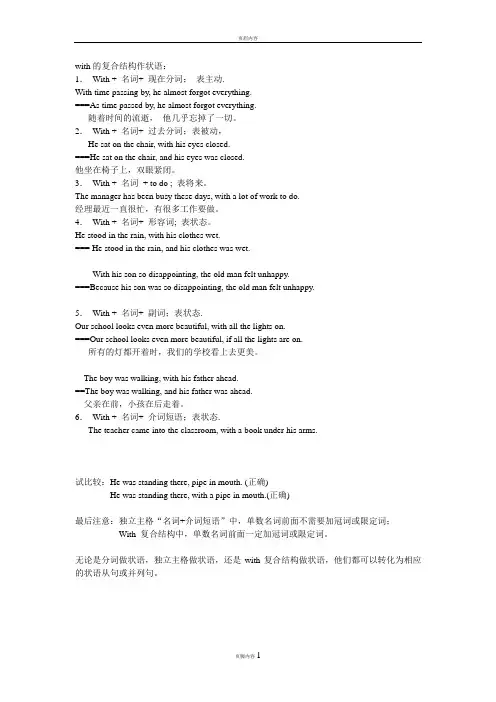
页眉内容with的复合结构作状语:1.With + 名词+ 现在分词;表主动.With time passing by, he almost forgot everything.===As time passed by, he almost forgot everything.随着时间的流逝,他几乎忘掉了一切。
2.With + 名词+ 过去分词;表被动,He sat on the chair, with his eyes closed.===He sat on the chair, and his eyes was closed.他坐在椅子上,双眼紧闭。
3.With + 名词+ to do ; 表将来。
The manager has been busy these days, with a lot of work to do.经理最近一直很忙,有很多工作要做。
4.With + 名词+ 形容词; 表状态。
He stood in the rain, with his clothes wet.=== He stood in the rain, and his clothes was wet.With his son so disappointing, the old man felt unhappy.===Because his son was so disappointing, the old man felt unhappy.5.With + 名词+ 副词;表状态.Our school looks even more beautiful, with all the lights on.===Our school looks even more beautiful, if all the lights are on.所有的灯都开着时,我们的学校看上去更美。
The boy was walking, with his father ahead.==The boy was walking, and his father was ahead.父亲在前,小孩在后走着。
1 With 的复合结构(with+ 复合宾语)with+ 复合宾语结构常作原因状语、伴随状语、定语等。
With + 名词/代词+名词With + 名词/代词+形容词With + 名词/代词+副词With + 名词/代词+介词短语With + 名词/代词+不定式(to do/ to be done 表示动作将要做 , 若句中主语发出动作,用to do , 若句中主语不发出这一动作,则用to be done With + 名词/代词+现在分词 (doing/ being done 表示动作与谓语动词同时进行,若是with 后的名词/代词发出动作,即所谓的主动,则用doing ; 若是被动,则用being done )With + 名词/代词+过去分词 (动作已结束,动词与前面名词/代词的关系是被动)He left home, with his wife a hopeless soul.She used to sleep with the windows open.She used to sleep with the light on.She came in, with a book in her hand.With all the work to do, I don’t know if I’ll have time to go out.With the boy leading us, we soon found the house.With the house being painted, we can’t move in.With everything I needed bought, I left the shop.2 独立主格结构一般来说,我们把With 复合结构中的with 去掉,就成了独立主格结构了。
如: She slept, the windows open.The prisoner stood there, his hands raised. ( 可以这样理解:hand 是被举起的,表示被动和完成)Time permitting, We ‘ll go for a picnic.(time和permit 是主动关系)She came in, book in hand. (注: book 和hand 之前不加任何代词或冠词,这与with 复合结构不同)还有不同的是,独立主格中出现了beingIt being a fine day, we decided to go swimming.There being no bus, I had to go home on foot.这两句话中的being 是由动词be 变来的,可以这样想:独立主格也是状语,所以不能使用谓语动词。
一:With复合结构与独立主格结构with复合结构与独立主格结构是英语中常见的两种结构形式。
从某种意义上说,它们可以算作是非谓语动词用法的延伸。
它们都可以在句中作原因状语、伴随状况状语、条件状语、时间状语或结果状语用,一般也可以相互转换。
虽然它们的语法功能和意义相同,但其结构形式和名称却不相同。
抓住这一点,就可以把二者融会贯通,从而在阅读中减少不必要的理解障碍。
with复合结构的模式是:with+名词/代词(作逻辑主语)+分词/形容词/副词/不定式/介词短语(作逻辑谓语)独立主格结构的模式是:主格名词/代词(作逻辑主语)+分词/形容词/副词/不定式/介词短语(作逻辑谓语)请看下例:一、作时间状语1、With winter coming on, the trees turn yellow and some birds fly south.=Winter coming on, the trees turn yellow and some birds fly south.2、With our work having been finished well, we went out for a holiday.=Our work having been finished well, we went out for a holiday. 3、With the traffic light green, the bus got moving.=The traffic light green, the bus got moving.4、With the wedding dinner party(being) over, we left the hotel.=The wedding dinner party(being) over, we left the hotel.二、作原因状语5、With it being Sunday, the library was closed.=It being Sunday, the library was closed.6、With the weather terribly cold, we entered the room to warm ourselves.=The weather terribly cold, we entered the room to warm ourselves. 7、With us to care for the children you are able to be carefree away from home.=We to care for the children, you are able to be carefree away from home.(注意此处的we 不得改成us,用了us便不是独立主格结构了。
1 With 的复合结构(with+ 复合宾语)with+ 复合宾语结构常作原因状语、伴随状语、定语等。
With + 名词/代词+名词With + 名词/代词+形容词With + 名词/代词+副词With + 名词/代词+介词短语With + 名词/代词+不定式(to do/ to be done 表示动作将要做, 若句中主语发出动作,用to do , 若句中主语不发出这一动作,则用to be doneWith + 名词/代词+现在分词(doing/ being done 表示动作与谓语动词同时进行,若是with 后的名词/代词发出动作,即所谓的主动,则用doing ; 若是被动,则用being done )With + 名词/代词+过去分词(动作已结束,动词与前面名词/代词的关系是被动) He left home, with his wife a hopeless soul.She used to sleep with the windows open.She used to sleep with the light on.She came in, with a book in her hand.With all the work to do, I don’t know if I’ll have time to go out.With the boy leading us, we soon found the house.With the house being painted, we can’t move in.With everything I needed bought, I left the shop.2 独立主格结构一般来说,我们把With 复合结构中的with 去掉,就成了独立主格结构了。
如:She slept, the windows open.The prisoner stood there, his hands raised. ( 可以这样理解:hand 是被举起的,表示被动和完成)Time permitting, We ‘ll go for a picnic.(time和permit 是主动关系)She came in, book in hand. (注: book 和hand 之前不加任何代词或冠词,这与with 复合结构不同)还有不同的是,独立主格中出现了beingIt being a fine day, we decided to go swimming.There being no bus, I had to go home on foot.这两句话中的being 是由动词be 变来的,可以这样想:独立主格也是状语,所以不能使用谓语动词。
高二英语独立主格结构with的复合结构试题答案及解析1. With a lot of difficulties _______, they went to the seashore and had a good rest.A.settled B.settling C.to settle D.being settled【答案】A【解析】考查with的复合结构。
在with的复合结构中动词的形式要看与其修饰的宾语之间的关系,主动关系用doing,被动完成关系用done。
句意:解决了许多难题,他们去了海边好好休息一下。
表示“问题已经被解决”,所以用settled。
答案选A。
【考点】考查with的复合结构2. _____ admission rate up by 60%, the school has had another excellent year.A.AsB.ForC.WithD.Through【答案】C【解析】随着录取率上升60%,学校又是一年辉煌。
这里使用了with复合结构,with+宾语+副词,注意as虽然可以表示“随着”,但是as是连词,不能接复合结构,所以选C。
【考点】考查with复合结构3. With dinner _____, the lady went on ____ some sewing.A.to prepare; to do B.preparing; doing C.prepared; to do D.to be prepared; doing【答案】C【解析】可以:晚餐准备好了,这个女士继续缝纫。
第一空使用了with复合结构“with+宾语+宾语补足语”,因为晚餐准备好了,所以用过去分词表示动作的完成,第二空填to do,go on to do sth继续做不同的事情,go on doing继续做相同的事情,所以选C。
【考点】考查with复合结构和词组4. With his money _________, he could not go home and had to lie on the street.A.using up B.missed C.running out D.run out【答案】C【解析】句意:他的钱用光了,他不能回家了,不得不住在街上。